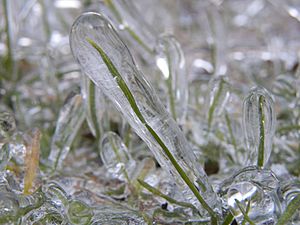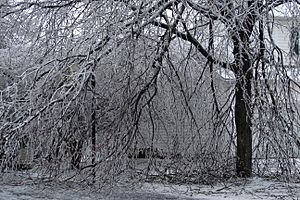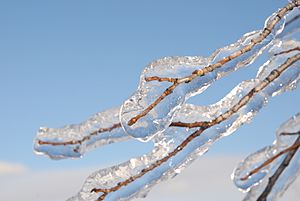Glaze (ice) facts for kids
Glaze ice, also called glazed frost, is a clear, smooth layer of ice. It forms when rain or drizzle freezes instantly as it touches a surface. Imagine water turning to ice the moment it lands on a cold tree branch or sidewalk!
It looks a lot like clear ice, which also comes from supercooled water droplets. Glaze ice often happens in winter in places with moderate climates. This is when rain starts in warm air high up but then falls through very cold air near the ground.
Contents
What Glaze Ice Does
Impact on Trees and Power Lines
When freezing rain is light, the ice layer is thin. It usually doesn't cause much harm, maybe just breaking off dead branches.
But if a lot of ice builds up, it becomes very dangerous. If the ice layer is thicker than about 0.25 inches (0.6 cm), tree branches can break. They become too heavy with the ice and can snap off. These heavy branches can then fall onto power lines.
Windy conditions make the damage even worse. Power lines covered in ice become extremely heavy. This can cause the support poles, insulators, and the lines themselves to break. This often leads to widespread power outages.
Danger on Roads
Ice on roads makes driving very risky. Unlike snow, wet ice offers almost no grip for tires. Vehicles can slide easily, even on gentle slopes.
Glaze ice is also hard to see. It forms exactly to the shape of the ground or object it covers. This means drivers might not notice it until it's too late to react safely.
Effects on Plants
Glaze from freezing rain can seriously harm plants. They simply cannot hold the heavy weight of the ice. Trees can snap because they are dormant and fragile in winter. Pine trees are also at risk because their needles catch a lot of ice.
However, some fruit farmers use ice to protect their crops! They spray water onto budding fruit. This creates a layer of glaze ice that actually insulates the buds. This ice layer protects the fruit from even colder temperatures, saving the crop from severe frost damage.
Hazard for Aircraft
Glaze ice is extremely dangerous for airplanes and helicopters. It causes ice to build up very quickly on the aircraft's structure. Most small planes and helicopters do not have special equipment to remove ice (deicing equipment).
Even large airplanes with advanced deicing systems can struggle in heavy freezing rain. Ice makes an aircraft much heavier. It also changes the shape of the wings, which reduces how much lift the plane can get. All these factors make it harder for the plane to fly, climb, or even stay level.
Pilots usually try to fly into warmer air to avoid ice. Normally, this means flying lower. But with freezing rain, the warmer air is actually higher up. This means planes need to climb to escape the ice, which can be very difficult and risky with ice already building up.
Risk for Ships
Ships also face danger from glaze ice. When ice forms on the upper parts of a ship (the superstructure), it adds a lot of weight. This extra weight can make the ship unstable, especially in rough seas, and could even cause it to tip over.
See also




